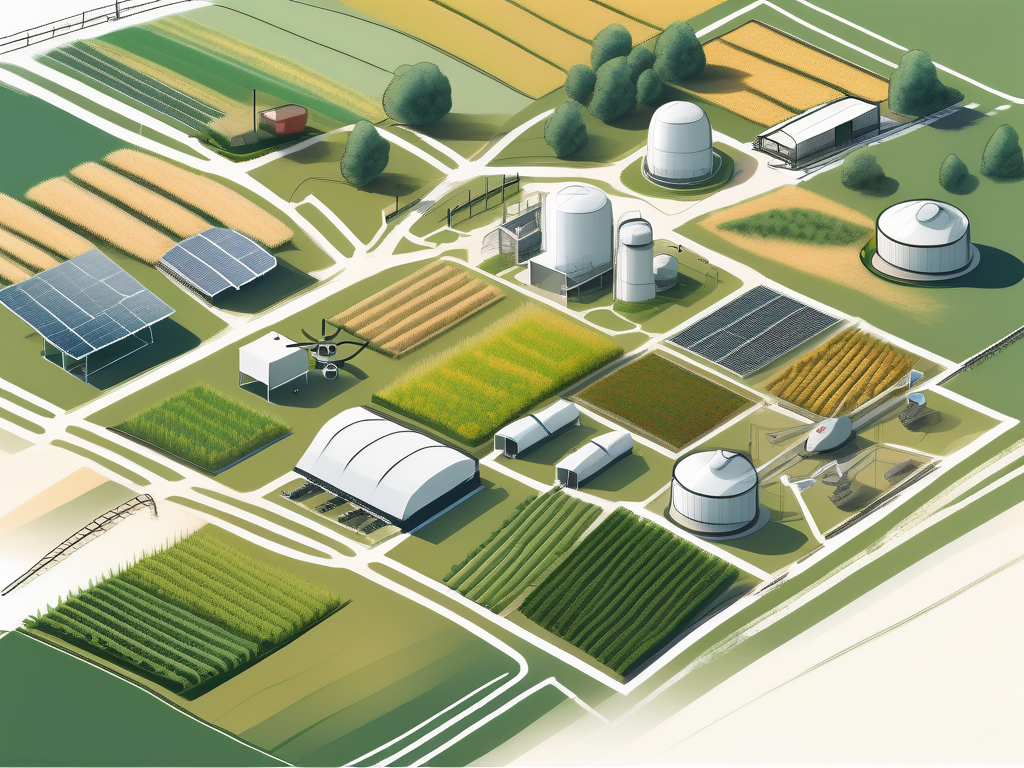
Busting Common Misconceptions About Agricultural Remote Monitoring
Remote monitoring in agriculture has revolutionized the way farmers manage their crops and livestock. However, there are still many misconceptions surrounding this technology. In this article, we will debunk these myths and shed light on the true benefits of remote monitoring in agriculture.
Understanding Remote Monitoring in Agriculture
The concept of remote monitoring involves the use of sensors and data analysis to monitor various aspects of agricultural operations. These sensors are placed in fields, livestock enclosures, irrigation systems, and even machinery to collect real-time data. This data is then transmitted to a central control system where it can be analyzed and used to make informed decisions.
Remote monitoring systems in agriculture have revolutionized the way farmers manage their operations. By utilizing cutting-edge technology, farmers can now monitor their crops, livestock, and equipment with precision and efficiency. The data collected from these sensors provides valuable insights into the health and performance of agricultural assets, allowing farmers to optimize their practices for better outcomes.
The Concept of Remote Monitoring
Remote monitoring is all about leveraging technology to monitor agricultural operations from a distance. With the help of sensors, farmers can gather data on soil moisture levels, temperature, humidity, and even livestock behavior. This enables them to make timely decisions and take appropriate actions to maximize yield and minimize losses.
Furthermore, remote monitoring systems can be integrated with weather forecasting tools to provide farmers with real-time weather data. This integration allows farmers to make data-driven decisions based on weather patterns, ensuring that they are prepared for any upcoming weather events that could impact their operations. By combining sensor data with weather information, farmers can proactively adjust their strategies to mitigate risks and optimize productivity.
The Role of Remote Monitoring in Modern Agriculture
In today's agriculture industry, remote monitoring plays a vital role in optimizing productivity and sustainability. By continuously monitoring various parameters, farmers can identify potential issues before they escalate, ensuring timely interventions and reducing crop loss. It also enables them to manage resources efficiently, such as water, fertilizers, and energy, leading to improved sustainability.
Moreover, remote monitoring systems can facilitate precision agriculture practices, allowing farmers to tailor their interventions to specific areas within their fields. By using data-driven insights to apply resources only where needed, farmers can reduce waste and environmental impact while maximizing the health and yield of their crops. This targeted approach not only benefits the farmers economically but also contributes to a more sustainable and environmentally friendly agricultural sector.
Common Misconceptions About Remote Monitoring
Remote monitoring in agriculture has gained significant attention in recent years, revolutionizing the way farmers manage their operations. However, there are still some misconceptions surrounding this technology that need to be addressed. In this article, we will debunk three common myths about remote monitoring and shed light on the truth behind them.
Myth 1: Remote Monitoring is Too Expensive
One of the most prevalent myths about remote monitoring in agriculture is that it is too expensive for small and medium-scale farmers. However, advancements in technology and increasing competition in the market have significantly reduced the cost of sensors and monitoring systems. This means that even farmers with limited budgets can now afford to implement remote monitoring solutions on their farms.
Moreover, the long-term benefits of remote monitoring far outweigh the initial investment. By accurately monitoring crucial parameters such as soil moisture, temperature, and humidity, farmers can optimize irrigation schedules, reduce water usage, and improve crop yields. Additionally, remote monitoring helps detect early signs of plant diseases or pest infestations, allowing farmers to take timely action and prevent significant crop losses. These benefits translate into increased profitability and a more sustainable farming operation.
Myth 2: Remote Monitoring is Unreliable
Another misconception is that remote monitoring systems are unreliable and prone to malfunctions. While no technology is immune to occasional glitches, modern remote monitoring systems are highly reliable. They undergo rigorous testing and use cutting-edge technologies to ensure accurate data collection and transmission.
Additionally, many remote monitoring systems provide notifications and alerts when anomalies are detected. This means that farmers can receive real-time updates on critical parameters and take prompt action if any irregularities are observed. Whether it's a sudden drop in soil moisture or a spike in temperature, remote monitoring systems empower farmers to make informed decisions and mitigate potential risks.
Myth 3: Remote Monitoring is Difficult to Implement
Some farmers believe that implementing remote monitoring systems requires technical expertise and is too complicated. However, many manufacturers offer user-friendly solutions that are easy to install and operate. The sensors can be simply placed in designated areas, and the data can be accessed through intuitive interfaces on smartphones or computers.
Furthermore, customer support and training are readily available to assist farmers in the initial setup and ongoing usage of remote monitoring systems. Manufacturers understand the importance of providing comprehensive guidance to ensure farmers can make the most out of their investment. With the right support and resources, farmers of all technical backgrounds can successfully implement remote monitoring and unlock its full potential.
As we have debunked these common misconceptions, it is clear that remote monitoring is a valuable tool for farmers looking to optimize their operations and improve productivity. By embracing this technology, farmers can make data-driven decisions, reduce costs, and ultimately achieve sustainable and profitable farming practices.
The Truth About Remote Monitoring in Agriculture
The Cost-Effectiveness of Remote Monitoring
Contrary to the myth, remote monitoring systems have proven to be cost-effective in the long run. By detecting and addressing potential issues early, farmers can minimize crop loss and optimize resource utilization, ultimately increasing profitability. The return on investment from improved productivity and reduced operational costs more than justifies the initial investment in remote monitoring technology.
Furthermore, the cost-effectiveness of remote monitoring extends beyond financial gains. By reducing the need for manual labor and physical inspections, farmers can save valuable time and focus on other critical aspects of their operations. This efficiency not only improves the bottom line but also enhances overall farm management practices.
The Reliability of Remote Monitoring Systems
Modern remote monitoring systems are designed to be highly reliable and accurate. The sensors are calibrated and undergo stringent quality control measures to ensure accurate data collection. Additionally, redundant data transmission protocols and backup systems are in place to mitigate the risk of data loss. This reliability enables farmers to make data-driven decisions with confidence, leading to better outcomes.
Moreover, the reliability of remote monitoring systems contributes to sustainable farming practices by promoting proactive problem-solving and resource conservation. With real-time data at their fingertips, farmers can respond promptly to changing conditions, reducing waste and environmental impact in the process.
The Simplicity of Implementing Remote Monitoring
Implementing remote monitoring systems doesn't have to be complicated. Manufacturers offer comprehensive support to guide farmers through the installation process, ensuring a smooth setup. Once installed, the user-friendly interfaces make it easy for farmers to access and analyze the collected data. As a result, farmers can quickly adapt to the technology and start reaping its benefits.
Furthermore, the simplicity of implementing remote monitoring systems fosters innovation and experimentation in agriculture. Farmers are encouraged to explore new techniques and strategies based on the insights provided by the technology, leading to continuous improvement and adaptation to changing market demands. This flexibility and agility are essential in today's dynamic agricultural landscape.
The Impact of Remote Monitoring on Agriculture
Improving Crop Yield with Remote Monitoring
Remote monitoring enables farmers to closely monitor crucial parameters like soil moisture, temperature, and nutrient levels. By maintaining optimal growing conditions, farmers can maximize crop yield and quality. Moreover, early detection of pests, diseases, or nutrient deficiencies allows for timely intervention, minimizing potential damage and ensuring healthy crops.
Furthermore, remote monitoring systems can be integrated with weather forecasting data to provide farmers with predictive insights. By analyzing weather patterns and trends, farmers can proactively adjust their farming practices to mitigate risks associated with extreme weather events such as droughts, floods, or heatwaves. This proactive approach not only helps in safeguarding crop yield but also contributes to sustainable farming practices.
Enhancing Farm Management Through Remote Monitoring
Remote monitoring provides farmers with real-time insights into their farms' operations. They can monitor livestock health, irrigation systems, and machinery performance, among other things. This enables efficient farm management, timely maintenance, and effective resource allocation. By automating routine tasks and streamlining operations, farmers can focus on strategic decision-making and overall farm improvement.
In addition, remote monitoring systems can facilitate data-driven decision-making by collecting and analyzing vast amounts of farm-related data. By leveraging data analytics and machine learning algorithms, farmers can gain valuable insights into trends, patterns, and correlations within their operations. This data-driven approach empowers farmers to make informed decisions regarding crop selection, planting schedules, and resource utilization, ultimately optimizing farm productivity and profitability.
The Future of Remote Monitoring in Agriculture
Technological Advancements in Remote Monitoring
As technology continues to evolve, so will the capabilities of remote monitoring in agriculture. We can expect further advancements in sensor technology, data analytics, and connectivity. Improved sensor accuracy, extended battery life, and enhanced data analysis algorithms will enable even more precise monitoring and decision-making in the future.
One exciting area of development in sensor technology is the integration of artificial intelligence (AI) and machine learning algorithms. These advanced technologies can help in predicting crop diseases, optimizing irrigation schedules, and even detecting nutrient deficiencies in plants. The combination of AI with remote monitoring systems holds great promise for revolutionizing how farmers manage their crops.
The Growing Acceptance of Remote Monitoring in Agriculture
The acceptance of remote monitoring in agriculture is increasing rapidly. More and more farmers are recognizing its potential to optimize operations, improve yield, and reduce resource waste. As the benefits become more evident and case studies highlight success stories, remote monitoring will likely become an essential tool in every modern farmer's arsenal.
Furthermore, the integration of remote monitoring systems with precision agriculture techniques is gaining traction in the farming community. By combining real-time data from sensors with GPS technology, farmers can create highly detailed maps of their fields, enabling targeted application of resources such as water, fertilizers, and pesticides. This not only maximizes efficiency but also minimizes environmental impact, showcasing the sustainable aspect of remote monitoring in agriculture.
In conclusion, remote monitoring in agriculture is not just a practical technology, but a transformative one. By dispelling the myths surrounding it, we can appreciate its true potential in revolutionizing farming practices. From cost-effectiveness to reliability and simplicity, remote monitoring offers invaluable benefits to farmers, ultimately leading to increased productivity, sustainability, and profitability.
